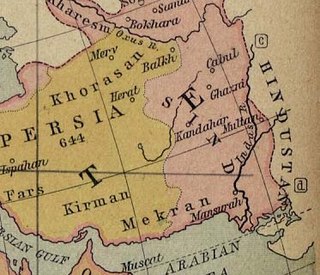Related Research Articles

Babur was the founder of the Mughal Empire in the Indian subcontinent. He was a descendant of Timur and Genghis Khan through his father and mother respectively. He was also given the posthumous name of Firdaws Makani.

Muhammad Shaybani Khan was an Uzbek leader who consolidated various Uzbek tribes and laid the foundations for their ascendance in Transoxiana and the establishment of the Khanate of Bukhara. He was a Shaybanid or descendant of Shiban, the fifth son of Jochi, Genghis Khan's eldest son. He was the son of Shah-Budag, thus a grandson of the Uzbek conqueror Abu'l-Khayr Khan.

Sultan Husayn Bayqara Mirza was the Timurid ruler of Herat from 1469 until May 4, 1506, with a brief interruption in 1470.

The Khanate of Bukhara was an Uzbek state in Central Asia from 1501 to 1785, founded by the Abu'l-Khayrid dynasty, a branch of the Shaybanids. From 1533 to 1540, Bukhara briefly became its capital during the reign of Ubaidullah Khan. The Khanate reached its greatest extent and influence under its penultimate Abu'l-Khayrid ruler, the scholarly Abdullah Khan II.

The Arghun dynasty ruled over the area adjoining Southern Afghanistan and then the Sindh Sultanate from the late 15th century to the early 16th century. Arghun rule can be divided into two branches: the Arghun branch of Dhu'l-Nun Beg Arghun that ruled until 1554, and the Tarkhan branch of Muhammad Isa Tarkhan that ruled until 1593.

Ghiyath al-Din Muhammad, commonly known as Khvandamir was a Persian historian who was active in the Timurid, Safavid and Mughal empires. He is principally known for his Persian universal history, the Habib al-siyar, which was regarded by both the Safavids and Mughals as their first official court account.
Muhammad Zaman Mirza (1496–1539) was a Timurid prince, and general to Mughal Emperors Babur and Humayun. He proclaimed himself the ruler of Gujarat in 1537 but did not gain actual control.

In 1504, Babur besieged Kabul and took the city from the Arghuns under Mukim Beg Arghun, to become the new king of Kabul and Ghazni regions. The territory gave him respite from his Uzbek troubles in Central Asia. It allowed him to build his nascent kingdom into a strong and formidable power in later years, enough to conquer northern India.

The Persian–Uzbek Wars were a series of conflicts between the Shaybanids and Safavid Empire of Persia fought between 1502 and 1510. The Safavid dynasty prevailed.

Abu Sa'id Mirza was the ruler of the Timurid Empire during the mid-fifteenth century.

In the early 16th century, Sultan Mahmud Khan, the Chagatai Khan of Western Moghulistan, and Sultan Ahmad Alaq Khan, the Chagatai Khan of Eastern Moghulistan, decided to counter the growing power of the Uzbeks under Muhammad Shaybani. Sultan Ahmed Tambol had rebelled against his Timurid master Babur and declared his independence. But when Babur tried to reconquer his territory with the help of his uncles, Ahmed Tambol sought the assistance of the Uzbeks. The two Moghul brothers united their forces and launched a campaign against Tambol, but Muhammad Shaybani surprised the Khans and proved victorious in battle of Akhsi and took them both prisoner.

Battle of Ab Darrah Pass was the battle that took place in 1511 in the place called Ab Darrah between Uzbeks and Babur of Timurids. The battle ended with the decisive Timurid victory which enabled Babur to regain Transoxiana and briefly reunite the whole of the ancestral part of the Timurid Empire. Such a decisive and significant battle is not mentioned in Babur’s Memoirs (Baburnama), in which there is a break from the year 1508 to the beginning of 1519.

Badi' al-Zaman Mirza was a Timurid ruler of Herat from 1506 to 1507. He was the son of Husayn Bayqarah, who was a great-great-grandson of Timur.

Khanzada Begum was a Timurid princess and the eldest daughter of Umar Shaikh Mirza II, the amir of Ferghana. She was also the elder sister of Babur, the founder of the Mughal Empire. She and her brother remained deeply attached to each other all their lives, a period during which the family progressed from ruling a tiny and obscure principality in Central Asia to ruling a large portion of the Indian subcontinent.

Sultan Mahmud Mirza was a Timurid prince from the branch of Transoxiana. He was the son of Abu Sa'id Mirza, the ruler of the Timurid Empire.
Masuma Sultan Begum was a Mughal princess and the daughter of the first Mughal emperor, Babur. She is frequently mentioned in the Humayun-nama by her sister, Gulbadan Begum, who calls her sister 'Elder sister Moon'.
Bayqara Mirza I was a Timurid prince and a grandson of the Central Asian conqueror Timur by his eldest son Umar Shaikh Mirza I.
Ulugh Beg II also known as Ulugh Beg Kabuli (d.1502) was the Timurid ruler of Kabul and Ghazni from 1461 to 1502.
Rukn-ud-din Ala al-Dawla Mirza, also spelt Ala ud-Dawla Mirza and Ala ud-Daula Mirza, was a Timurid prince and a grandson of the Central Asian ruler Shah Rukh. Following his grandfather's death, Ala al-Dawla became embroiled in the ensuing succession struggle. Though he initially possessed a strategic advantage, he was eventually overtaken by his more successful rivals. Ala al-Dawla died in exile after numerous failed attempts to gain the throne.
Khadija Begi Agha was a Timurid royal consort. She was the concubine of Abu Sa'id Mirza, the legal wife of sultan Husayn Bayqara, and the mother of Muzaffar Husayn Mirza. She belonged to the few politically influential women of the Timurid dynasty.